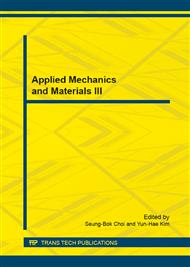p.194
p.198
p.205
p.210
p.215
p.224
p.229
p.234
p.240
Dynamical Equations of Flexible Multibody Systems under Lie Group Framework
Abstract:
A new type of dynamic equations of flexible multibody systems is derived via virtual work principle together with floating frame approach. The absolute Cartesian coordinates are used to describe positions of floating frames’ origins of deformable bodies; The orientation transform matrices as special orthogonal groups are used to describe rotation motions; The modal coordinates are used to express small deflections of deformable bodies with respect to the corresponding floating frames. The resulting equations are mixed classic Euler-Lagrange equations of translational motion of bodies and deformation and Euler-Poinaré equations of rotation in Lie groups and Lie algebras, the Lie-Poisson equations as reconstruction equations obtaining Lie Groups from Lie algebras, constraint equations Lie groups and Lie algebras. In order to simplify the implementation, we separate the constant coefficient matrices in generalized mass matrices and generalized forces in detail. The results can be easily used to design geometric integrators of Lie group structure preserving.
Info:
Periodical:
Pages:
215-223
Citation:
Online since:
January 2015
Authors:
Price:
Сopyright:
© 2015 Trans Tech Publications Ltd. All Rights Reserved
Share:
Citation:


